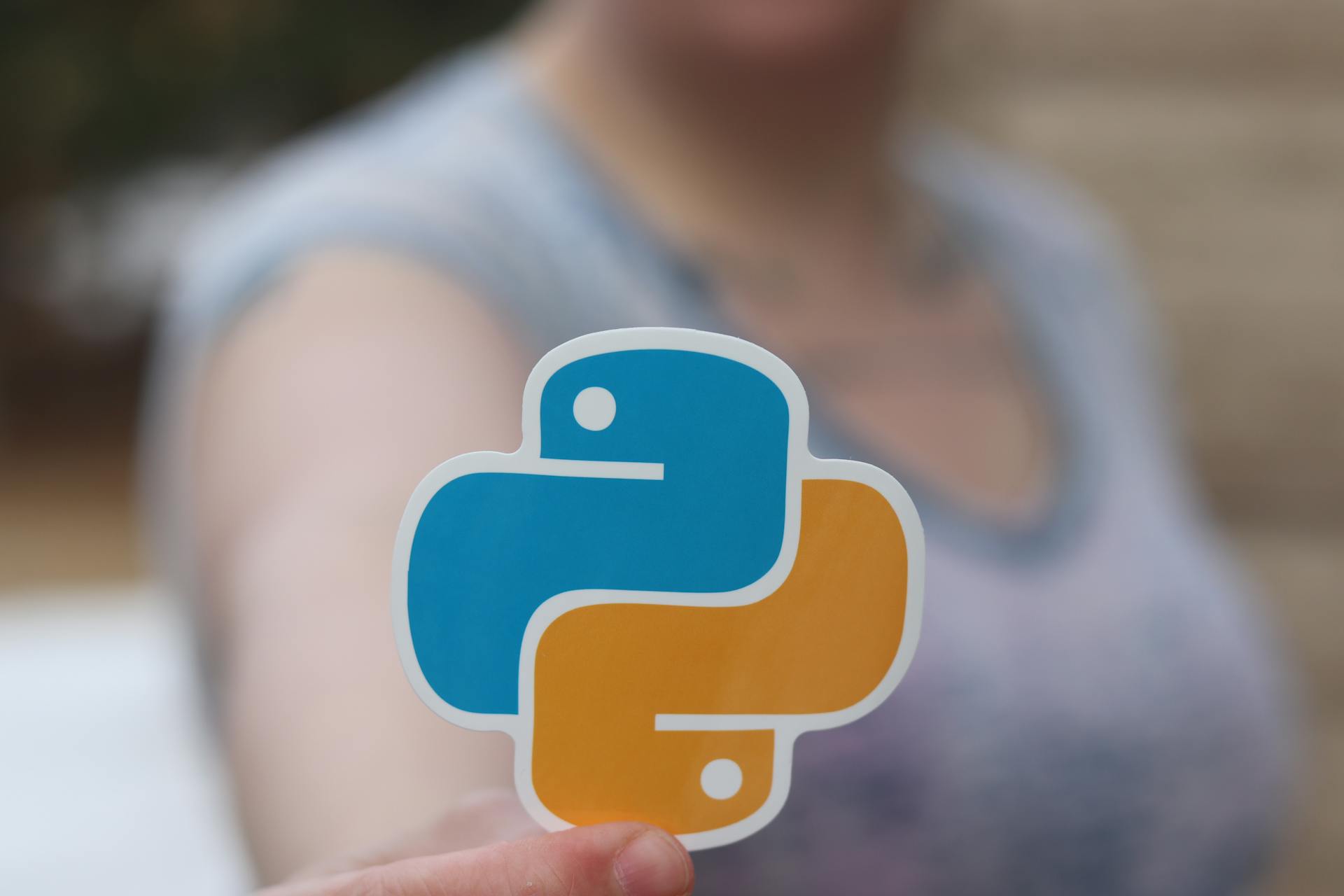
Getting started with the CoinMarketCap API in Python is a great way to access a vast amount of cryptocurrency data.
The CoinMarketCap API provides a simple and intuitive way to fetch data on cryptocurrencies, exchanges, and more. You can use this data to build your own projects, such as cryptocurrency price trackers or market analysis tools.
To get started, you'll need to sign up for a CoinMarketCap API key on their website. This key will be used to authenticate your API requests and give you access to the data you need.
With your API key in hand, you can start making requests to the CoinMarketCap API using Python.
Check this out: Htx Coinmarketcap
Data Retrieval
You can obtain the latest listing data using the CoinMarketCap API, specifically through the CMC latest listings endpoint, which provides a list of all active cryptocurrencies with their latest market data.
To get started, you'll need to import the CMC library and set up the client. You can then make a call to obtain the overall data for a specific cryptocurrency, such as Bitcoin.
The CoinMarketCap API also provides metadata through the CMC metadata endpoint, which returns static data for a specified cryptocurrency, including its logo, description, website URL, and social links.
You can use the global-metrics option to obtain data on the global market, with two endpoints available: historical and latest quotes. The latest quotes endpoint is available for the basic plan, and it provides real-time data on the market.
Here's a summary of the data retrieval options available through the CoinMarketCap API:
How to Get Metadata via API
To get metadata via API, you can use the CoinMarketCap API. The CMC metadata endpoint returns all the static data that is available for the specified cryptocurrency. You'll need to import the CMC library and set the client up.
To make a call for the overall data for the Bitcoin cryptocurrency, you can use the following code: cmc.cryptocurrency_info(symbol='BTC'). The metadata obtained contains the logo, description, website URL, various social links, and other information.
You can pass the symbol parameter like cmc.cryptocurrency_info(symbol='BTC') or with the slug parameter like cmc.cryptocurrency_info(slug='bitcoin'). If you want to specify a version of the endpoint, you can pass the api_version keyword argument directly to a method.
Get Fiat Data
To get Fiat data using the CoinMarketCap API, you'll need to call the /fiat/map endpoint. This endpoint is part of the CoinMarketCap API, which is a powerful tool for retrieving real-time and historical data on thousands of cryptocurrencies.
The CoinMarketCap API has a free edition that allows for 10,000 calls per month, which is perfect for small projects or testing. However, this version only maintains data on the last month, week, and 24 hours.
To access the Fiat data, you'll need to generate an API key on CoinMarketCap.com and store it safely. Once you have your API key, you can use it to call the /fiat/map endpoint.
Here are the steps to get Fiat data using the CoinMarketCap API:
- Call the /fiat/map endpoint
- Use the free edition of the API, which allows for 10,000 calls per month
- Generate an API key on CoinMarketCap.com and store it safely
Note: Some endpoints, like /fiat/map, are available in the free edition of the API, while others may require a paid plan. Be sure to check the documentation for the specific endpoint you're using.
Global Metrics

The CoinMarketCap API offers a global metrics option with two endpoints: historical and latest quotes. The latest quotes endpoint is available for the basic plan.
To get started, you'll need to import the relevant library, authenticate your API key, and call the endpoint. The historical endpoint is not available for the basic plan, so you'll want to focus on the latest quotes for now.
The latest quotes endpoint provides real-time data, which can be useful for applications that require up-to-date information. You can use this data to track the current market trends and make informed decisions.
To access the latest quotes, you'll need to make a GET request to the endpoint with your API key. This will return a JSON response containing the latest quotes for the specified cryptocurrency.
Consider reading: Bitcoin Atm Milwaukee - Coinhub
Direct Usage
To get started with the CoinMarketCap API, you'll need to obtain your API key from the CoinMarketCap website. Just click on the "GET YOUR API KEY NOW" button and fill up the sign-up information.
Additional reading: Coinmarketcap Binance

You can install the CoinMarketCap library with the following command: `pip install python-cmc`. This will allow you to use the API in your Python scripts.
The CoinMarketCap API has a variety of methods, including `cryptocurrency_map`, `cryptocurrency_info`, and `cryptocurrency_listings_latest`. You can use these methods to retrieve data about cryptocurrencies, exchanges, and more.
Here are some examples of how to use the CoinMarketCap API methods:
You can pass the symbol parameter to the `cryptocurrency_info` method like this: `cmc.cryptocurrency_info(symbol='BTC')`. Alternatively, you can pass the slug parameter: `cmc.cryptocurrency_info(slug='bitcoin')`.
API Pricing
API Pricing is straightforward with the CoinMarketCap API. You can choose from five plans, including a free one.
The free plan gives you access to nine market data endpoints, which is a great starting point. However, if you need more features, you can upgrade to one of the paid plans.
The paid plans include the STARTUP, STANDARD, and PROFESSIONAL plans, which give you access to more market endpoints, including historical data and OHLCV.

Here are the details of the paid plans:
The free plan also comes with a limitation of 10,000 API call credits per month, which is a good amount for small projects or testing. If you need more credits, you can upgrade to one of the paid plans, which offer up to 3 million or more API call credits per month.
Take a look at this: Bitcoins Transactions per Second
Direct Usage Popularity
Direct Usage Popularity is a key indicator of a project's relevance and usefulness. The python-coinmarketcap package on GitHub has been starred 118 times, which suggests that it has a dedicated community of users.
This level of engagement is a testament to the project's value and potential for real-world application. The project's GitHub repository provides a clear picture of its usage and popularity.
The 118 stars on the python-coinmarketcap package indicate a moderate level of interest and adoption. This could be an attractive feature for developers looking to integrate cryptocurrency data into their projects.
You might enjoy: The Graph Ecosystem Coinmarketcap
Python API

The Python API is a powerful tool for interacting with the CoinMarketCap API. You can use the CMC library to import and set up the client.
To obtain crypto metadata, you'll need to make a call to the CMC metadata endpoint, which returns all the static data for a specified cryptocurrency, including the logo, description, website URL, and social links.
The CMC library is a non-official Python package that wraps the CoinMarketCap API, allowing you to monitor and watch the crypto market.
You can use the CMC API with the following clients: Python, Node.js, Java, PHP, C#, Go, Google Sheets, and Excel.
Here are the available methods for the CMC library:
- debug: set verbosity.
- sandbox: In case of default sandbox API key changes, see Issue #1.
- logger: you can give a custom logger.
- version: set the version in the URL, for futures version.
You can also enable a debugging mode by setting the debug parameter to True when initializing the main class.
To get started with the Python API, you'll need to read the official API documentation and obtain an API Key on the Developer Portal for the pro version.
Here are the steps to follow:
1. Import the CMC library.
2. Set up the client with your API Key.
3. Make a call to the CMC metadata endpoint to obtain crypto metadata.
4. Use the CMC library to monitor and watch the crypto market.
By following these steps, you'll be able to harness the power of the CoinMarketCap API using Python.
Making Requests
The CoinMarketCap API for Python is a powerful tool for fetching cryptocurrency data. It has eight endpoints and four endpoint paths available for use.
To start making requests, you'll need to have a key, which you can obtain after setting up the API. This will allow you to access the data you need.
The API has a specific endpoint path that points to the /quotes/latest path, which is where you'll be fetching data for this project.
Making Requests

Now that we have our API key, we're ready to start pulling data. The API has eight endpoints available.
For this project, we'll be using the /quotes/latest path, which is the same path used to fetch data for a specific crypto symbol.
To make a request, we'll need to specify the crypto symbol we want data for. This is done by creating a dictionary called parameters that gets passed into session.get().
The session.get() function takes two main parameters: the crypto symbol and the endpoint path. In this case, the endpoint path is the /quotes/latest path.
With the parameters dictionary in place, we can use the session.get() function to fetch the data we need.
For more insights, see: Bit Coin Quotes
Request Multiple Symbols
Requesting data for multiple symbols at once is a big time-saver. The API requires a string of comma-separated strings, which we can create from a list.
To do this, we can use a list with the symbols we want to request data for. This list can then be integrated into the previous request function.
For another approach, see: Bitcoin Atm Tampa - Coinhub
The API will return a long blob of data, repeating for each symbol. This is where the cleaning function comes in, which needs to be modified to process data returned from multiple symbols.
We can use list comprehension to loop through each symbol being requested and restructure the response dictionary to include an entry for the symbol. This entire list of dictionaries can then be converted into a DataFrame.
For your interest: Python Get List of All Stock Ticker Symbols
Coins List
To get a list of all active cryptocurrencies, you can use the CoinMarketCap API's /v2/listings/ endpoint. This endpoint displays all active cryptocurrency listings in one call.
You can use the "id" field from the Ticker endpoint to query more information on a specific cryptocurrency.
The CoinMarketCap API's /v2/listings/ endpoint is the way to go if you need to fetch a list of all active cryptocurrencies.
To convert the data into a preferred currency and rank it differently, you can use the CMC latest listings endpoint.
You might like: Altcoins List on Binance
Frequently Asked Questions
How to use CoinMarketCap API in Python?
To access the CoinMarketCap API in Python, navigate to the endpoint overview and click into the "Cryptocurrency" section to retrieve the endpoint URL. From there, you can use the provided parameters to make API calls and retrieve data.
Is CoinMarketCap API free?
Yes, CoinMarketCap API offers a free plan, allowing users to access its data. However, a paid plan is also available for more advanced features and higher usage limits.
How to get API key from CoinMarketCap?
To get your CoinMarketCap API key, navigate to the Overview section of your account on https://pro.coinmarketcap.com/account and click the "Copy Key" button. Your API key will be copied to your clipboard instantly.
Sources
- https://github.com/shyuntech/coinmarketcap-api
- https://algotrading101.com/learn/coinmarketcap-api-guide/
- https://stackoverflow.com/questions/73726349/looping-through-coin-market-cap
- https://medium.com/@ericfflynn/building-a-cryptocurrency-portfolio-tracker-with-python-8d94b4aeea04
- https://snyk.io/advisor/python/python-coinmarketcap
Featured Images: pexels.com


